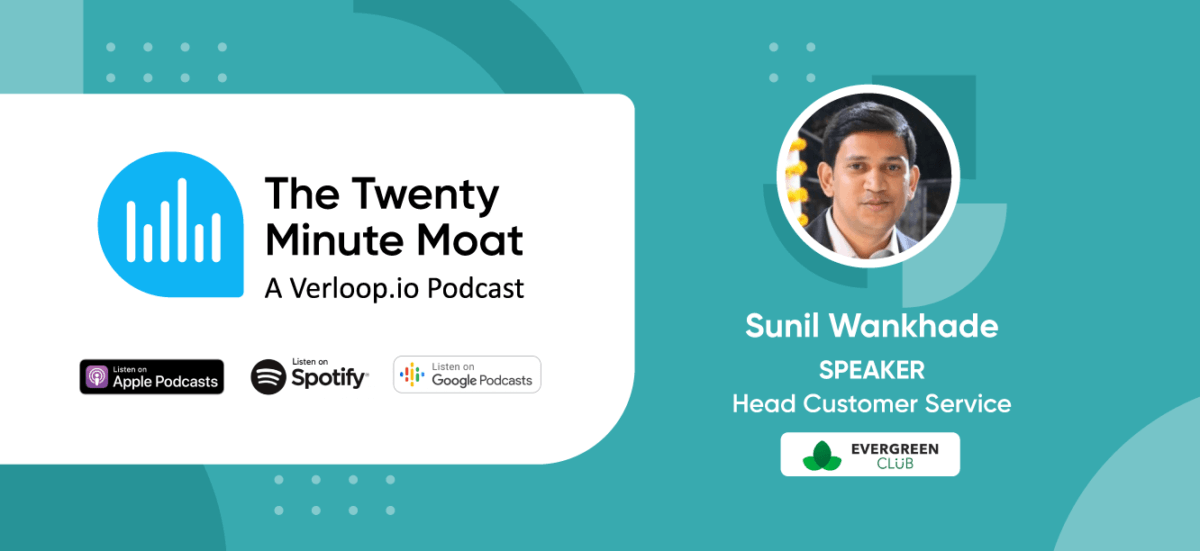Duration 17:26
Guest Speaker
Industry
Fintech
Fasih Abbas heads the Customer Success team of Cashfree and has an overall experience of 19 years managing businesses, people and growing them exponentially. He has over 10 years of CS leadership experience working with many of India’s largest e-commerce and Fintech brands.
We cover:
- Understanding support at Cashfree
- The Fintech boom and how has customer support scaled
- Impact of the pandemic on the Fin-tech space
- How has Cashfree’s customer support infrastructure adapted to these changes
Podcast Transcript
In this customer support challenges podcast, we have Fasih Abbas as our podcast guest and Siddharth Sharma as our podcast host.
Siddharth Sharma
Today I have someone with me who has seen the rise of customer success, the rise of customer support, and is working in an industry that has grown exponentially.
Forget quarter on quarter, but month on month as well.
I’m pleased to welcome Fasih to the discussion today. Fasih welcome to the show.
Why don’t you tell the listeners a little bit about yourself and your industry?
Fasih Abbas
Thank you very much, Siddharth.
In fact, I’ve been with the Fintech industry for a little over three years now. And prior to that I was with eCommerce and I have been with customer experience for almost two decades now.
I worked with very good and vibrant startups before joining Cashfree.
I’m currently with Cashfree, close to about a year now. And, prior to this, I have worked with brands like NiYO. I worked with PhonePay and where…
I’ve worked with Flipkart., right?
[01:07] Fasih Abbas
A little about the industry.
The Fintech… I think has been doing great and we’ve… we’ve actually witnessed this.
Right from the time that, you know, the… the demonetisation happened to where we are today.
I think this industry has fast grown and it continues to grow.
I think the subsequent questions will actually help me answer a lot more in detail about the fintech space and, you know. the industry itself.
[01:35] Siddharth Sharma
Sure. So coming onto the Fintech part of it, right.
Like we all know it’s growing rapidly and, like I said, not even quarter on quarter but month on month.
Over the last 1.5 years since the pandemic has struck, what’s been your insight into… as to how the industry has grown.
And specifically how has customer experience has changed or grown over the last…I mean, from the time pandemic hit.
[01:57] Fasih Abbas
Sure, I think it’s a very nice question.
I think the Fintech space is one which has really, really encashed.
You know, during the pandemic period. I would like to, you know, quickly take you through the recent events.
Maybe I’ll talk about 2020?
And that’s the year when… the year one, of the Pandemic.
We saw some major investments coming in the first half-year itself in 2020. And, I would like to say that in the second half we saw some major capital raisings from the likes of Pinelabs, Razorpay and, talking about these two companies in itself, you know.
I think they raised about $100 million. Talking about, you know, the growth. Overall, it has been fantabulous.
CashFree has been doing great and, you know.
Basically, you know, overall, the Fintech space has been doing wonderful.
I would also like to quote about UPI as a space, right?
I was just tracking some numbers and, you know, I think the growth has been over a 100% year on year.
And, just to quote a number right, the overall transactions on UPI itself has more than doubled up, right?
It was about a 1.25 billion transactions that have happened the previous year to this year, about a 2.73 billion transactions.
So that’s been huge and really big.
[03:33] Fasih Abbas
So that’s… that’s about, you know, how the fintech has, you know, taken speed and, you know, during the pandemic, I think it… it has just been moving up and growing bigger and bigger.
I think in the B2C space, people have really opted for digital payments and not wanting to actually, you know, use cash and, you know.
Use any other moment…uh…
Modes which really requires the touch of the device or touch of a card or touch of, you know, physical wallets.
I think that is one thing which is really driven.
Secondly, I think it’s also about… you know, a lot of business. You know, moving online and, you know, people paying online and getting their goods and services.
Not wanting to step out of their homes, and I think that is one of the key drivers
Which has really driven high during the pandemic period.
[04:25] Siddharth Sharma
That is pretty interesting, because, you know, we all… when we talk about it in our circles and we’re all like, ok, you know, pandemic must have pushed the Fintech players and we all…
And it’s like a statement that we make without any knowledge.
But thank you so much for giving us the data and the figures around it.
Like with a lot of growth as… I mean, and you have been a part of e-commerce site and I’m just borrowing it from there.
There’s is this famous saying that, you know.
With the part of growth also comes a lot of pain, right?
Fasih Abbas
Right.
Siddharth Sharma
And generally the pain is in the customer support side.
Because yes, there are a lot of queries and you’re building it on the go, right.
So can you tell me, what is customer support like in your organisation?
[05:01] Siddharth Sharma
Could you also elaborate on the structure when it comes to the support section and generally in fintech, like, help us break down what a structured team looks like.
Fasih Abbas
Yeah. I would like to take that question, you know, more from a perspective of me spending some time in the last three fintech.
You know, startups that I worked with, right. I think first of all, with rapid growth comes, you know, bigger challenges.
And, you know, these organisations have called it as… as a happy problem.
You know, more and more volumes and more and more business and more than you know, what they would have anticipated.
So, with that, right, there is obviously going to be load on the customer experience teams.
And… I think, you know, what… what would really happen is basically, you know, it goes through uh… survival mode
To a mode of, you know, transition where you are getting better and better. And then, you know, you actually come into an established mode.
Fasih Abbas
But to begin with, right, the structure in any fintech companies would be largely about, you know, how you actually respond to the end users.
How you respond to your merchants, and, you know, How do you actually solve their problems?
Let me talk about the various teams that get involved.
Fasih Abbas talks about customer problems resolution
The first and the basic team that plays a role is the line one team or the level one team.
Which actually takes the basic queries and answers them.
And I would say, having worked with various startup companies, there could be close to about a 95-96% of those queries which actually are answered and resolved then and there.
But there are a good 5 to 6% of those queries which do not get answered instantly.
And they have to be taken back to a back end team or a support team and have to be actually resolved.
And I think this is where, you know, you actually transfer this ticket out.
And there’s another team, the level two team or the line two team which kicks in and it does those follow ups with those back end teams and ensures that the resolutions are uh…attained.
And, you know, those resolutions are again passed on to the merchants and the customers.
Another important thing has been the social media support or… you know,
In various organisations it’s also called ORM team or the Online Reputation Management team.
Fasih Abbas
This has been a space where brands feel that, you know, they should maintain a good hygiene. They should maintain a good response system here and, you know, keep giving the right responses.
There could be a lot of customers coming and talking ill about your brand.
Talking about various, you know, bad experience either with the product or with, you know, the services that you are getting. Uh…
If you have a professional team which is having the right language, who can understand the sentiment of the customer
And respond exactly with the way, you know, the… the organisation wants it.
And what you call it as the brand tonality.
If the brand has actually, you know, given that particular description, or if the leaders feel, yes, they have to be a very formal brand on the social space.
Then you need to actually, you know, understand that and your team members on social media responses have to actually give very formal responses.
But if you have, you know, a brand which needs to be a little cheeky and, you know, it’s OK to be casual,
You have to actually, you know
Be like that.
But the key to the social media is about ensuring that, you know, you understand.
And, you know, you connect well with, you know, the customer on the other side.
[08:57] Fasih Abbas
And you are actually, you know, delivering those responses which really touch the heart of not only the end user who’s actually posting it on the social media
But you are actually letting a 100 or 1000 of them, you know, feel nice about your response, right?
I think, so that’s a social media team which is relevant in the fintech space. And then, you know.
Talking specifically about customer experience, there are a lot of back end teams, you know.
Which play a very, very important role. One of the teams is the design team.
The design team, basically, you know, designs the processes in terms of, you know, how a particular query needs to be actually understood.
How do you think, you know, you need to go and find more relevant information to that particular query on the systems?
And then, you know, going back to the right responses. But it also talks about, you know, what needs to happen on the level two side.
You know, how should the query flow into the level 2? What exactly is the response that we need to fetch from those relevant teams?
And ensuring that those resolutions are coming by this particular time and in a particular fashion.
And then, you know, you actually go back and close loop with the, you know, end users.
Fasih Abbas talks about experience
I think the design team also is slowly controlling the overall knowledge And, you know, the… the way, you know, the responses are built.
And this is a team which also works very closely with the training function in the customer experience team. Then comes, you know, the training team which actually controls the knowledge of the teams.
And, you know, ensures that the right knowledge is actually passed on. People understand the, you know, the product, the concepts. And then also understand the processes that the organisation wants to actually run.
You know, ensuring that the knowledge retention is there. Basically, you know, trying to check regularly and passing on refresher trainings.
There’s another team which is the quality team. Which, you know, is the team which I don’t need to explain in detail.
But this is the team which generally, audits and understands, you know, how good the work is.
And, uh…you know, if the processes are followed properly or not. And if the processes aren’t followed or if there is an error. Those things are actually captured
And the feedback is actually passed on to the operations team.
So that the operations team gets better on those particular queries and, you know, comes out of these errors and delivers a better quality score.
Uh…not going further in detail, but you know the quality team has a lot that it can do, just not, you know, just auditing and it’s not a…a check box that they need to keep ticking.
But also basically understanding how better the product can function. How better the agent can function and capturing those, you know, needs in a very, very detailed manner.
And passing it on to the product teams and to the operations team for corrections to happen. I think that is another important function.
Yet another function which a lot of the organisations are still starting, I would say, is the analytics function. You know,
Basically understanding, you know, what is uh…really driving the volumes?
You know, what is causing, you know, the numbers to be really high on a specific type of a question? Ah….You know..
Fasih Abbas
Then going in detail to understand, you know, how can we actually solve this problem, right? For example, you know, let’s say that there’s a particular query on bill payments and… uh…and
You see that the volumes are really high.
Then going into the details and trying to find out which, you know, particular operator related queries are coming?
And in that particular operator queries, trying to find out what kind of queries are coming?
Is that a fulfilment problem or is there anything else which is causing the problem? And then, you know, going back to those relevant teams and passing on those analytics.
And then the business teams get into, you know, action and try to come out of this problem. Try to solve those problems at the operator end.
Or, if there’s a product problem, internally that also gets solved.
And there’s… there is another backend team which, you know, huge customer experience teams, actually, you know, would have to keep.
But if these are startup’s which are having smaller teams, less than say about 30 odd people, then you don’t need this function.
This function I’m talking about is the workforce management and the real time analysts, right?
The workforce management is basically, you know, trying to understand, you know, what… what amount of people need to be put at, you know, at which day and at which hour, right?
So they basically look at 2-3 things. One, you know, they definitely look at, you know, what amount… what percentage of queries… uh…Uh based on the kind of business transactions or based on the count of active merchants are coming in.
Fasih Abbas
And then, you know, trying to plant that according to a volume pattern which they keep looking at in the recent weeks. And maybe, you know, the volumes are going to be high on a Monday in the first half.
To a bit lower in the afternoon to absolutely again high on a Monday evenings. And then, you know, the volumes…
That way, on a Tuesday, Wednesday and seeing that the volumes are actually dropping by a Thursday or a Friday.
And you don’t need to be putting a linear staff, you can actually, you know, increase the staff or reduce the staff.
So I think that’s another team. Another critical team which is shaping up and is going to be the future for a lot of people who are looking at career is the bot administration team.
So what does this team do?
This team actually, you know, works with the product teams. Or if it is a bot that is from a third party organisation, they actually coordinate between the design team in CX
And then, you know, with the bot product team or with the bot third party team.
I’ve largely spoken about, you know these various teams which are in fintech startups in a B2C kind of an environment. In a B2B, all of these teams also play an important role.
But yet another team which is at the very beginning. Is the integration support team or the on boarding support team which basically, you know, looks at, you know
How we can support integrations on our platform better and how onboarding can be seamless for the customers.
[15:52] Siddharth Sharma
Thank you so much for that. From what I understood, it requires a well oiled engine to run a good support in an experience centre for any brand.
And I think all the Fintech folks listening out there, or any entrepreneurs and any leaders, and this is how you should structure your experience team if you have not done so already.



